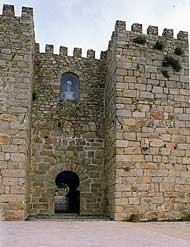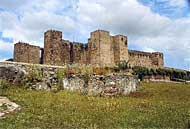The moorish castle in Trujillo
The location
The castle, situated on the highest point in the city (Cabeza de Zorro), looks over the entire community. The castle of Trujillo is not an isolated fortress in the middle of a field, but a part of the city itself. It was meant to endure long sieges. It is made up of two main buildings and the remains of a bulwark. It was originally a Muslim fortress, built during the time of the caliphs (the 10th century). Its builders had used the Roman models that already existed at the time to guide their construction.
Development (overview)
The castle at Trujillo may be the only example of Muslim fortresses built with stone before the year 1000.
When the Arabs saw the threat of the Castilian army nearing Extremadura, they surrounded the town with a strong wall. The fortress was not the center of the enclave, but rather on one side, so that it could be abandoned without going into the town if the enemy were to successfully surpass the wall. Thus the castle became a fortified warehouse within the city, perfectly defendable by the 11th century.
The fortress has two parts. The first is shaped like a square. The second is more modern and less regular, and is called the albacar.
The fortress has undergone many changes throughout the years. The most important took place during the war with Portugal
The watch towers on the west side and the two long structures in the northeast and southeast corners appear to be Muslim additions as well, possibly created by the Almohad tribe in the late 12th or early 13th century. The Christians also added many things to the fortress, i n particular during the 15th century, when the castle was the center of quite a few conflicts.
During the 14th century it served as a "treasure chest" where Samuel Leví, treasurer to King Peter I (The Cruel), stored the Royal Treasure.
In the late 15th century, there was a conflict about who was to receive the Crown. Some favoured princess Juana la Beltraneja of Castile, while others rooted for the Catholic Monarchs, Ferdinand and Isabella. Juana la Beltraneja took refuge in the castle at Trujillo when she arrived with her 600 horsemen and 1000 infantrymen to reach a martial agreement with the king of Portugal. She was forced to go to Placencia when a group of supporters of Ferdinand and Isabella, led by Luis de Chaves, opposed the presence of her troops.
At about the same time, late 15th century, the hermitage of San Pablo was built within the second section of the castle. The two cisterns in the northeast corner of the main structure are more interesting. They appear to be Muslim handiwork from the late 12th century as well.
In the mid-20th century an old Arab door was accidentally discovered behind the chapel stairway. The stairway ran between the two towers, on the exterior of the castle, to the castle dedicated to the Virgin Mary.
The entrance consists of a double door under a horseshoe arch, flanked by two square towers. Because it was meant primarily for defence, the castle has no residential areas on the inside. None of the towers stands out above the others. Because the city of Trujillo has never been controlled by feudal lords or noble families, it has no coat-of-arms on prominent display in the castle, not even that of the royal family.
In the 19th century the castle had fallen into severe disrepair and has been under restoration in the 20th century.




